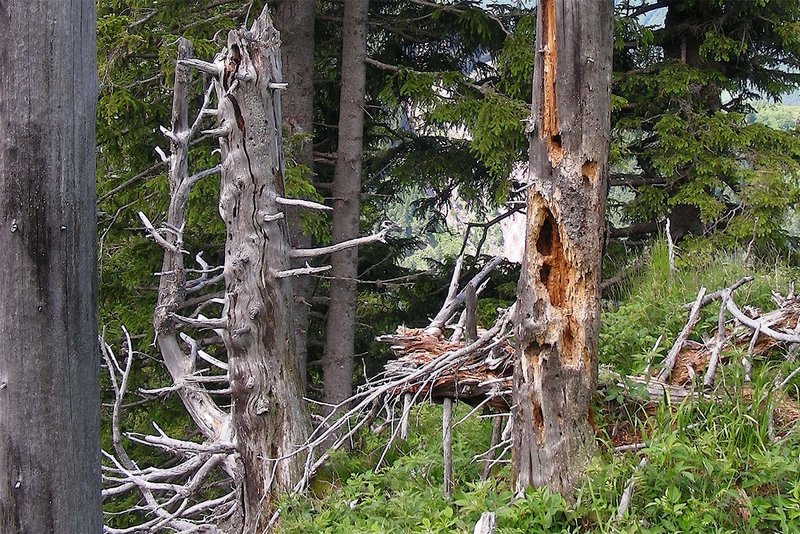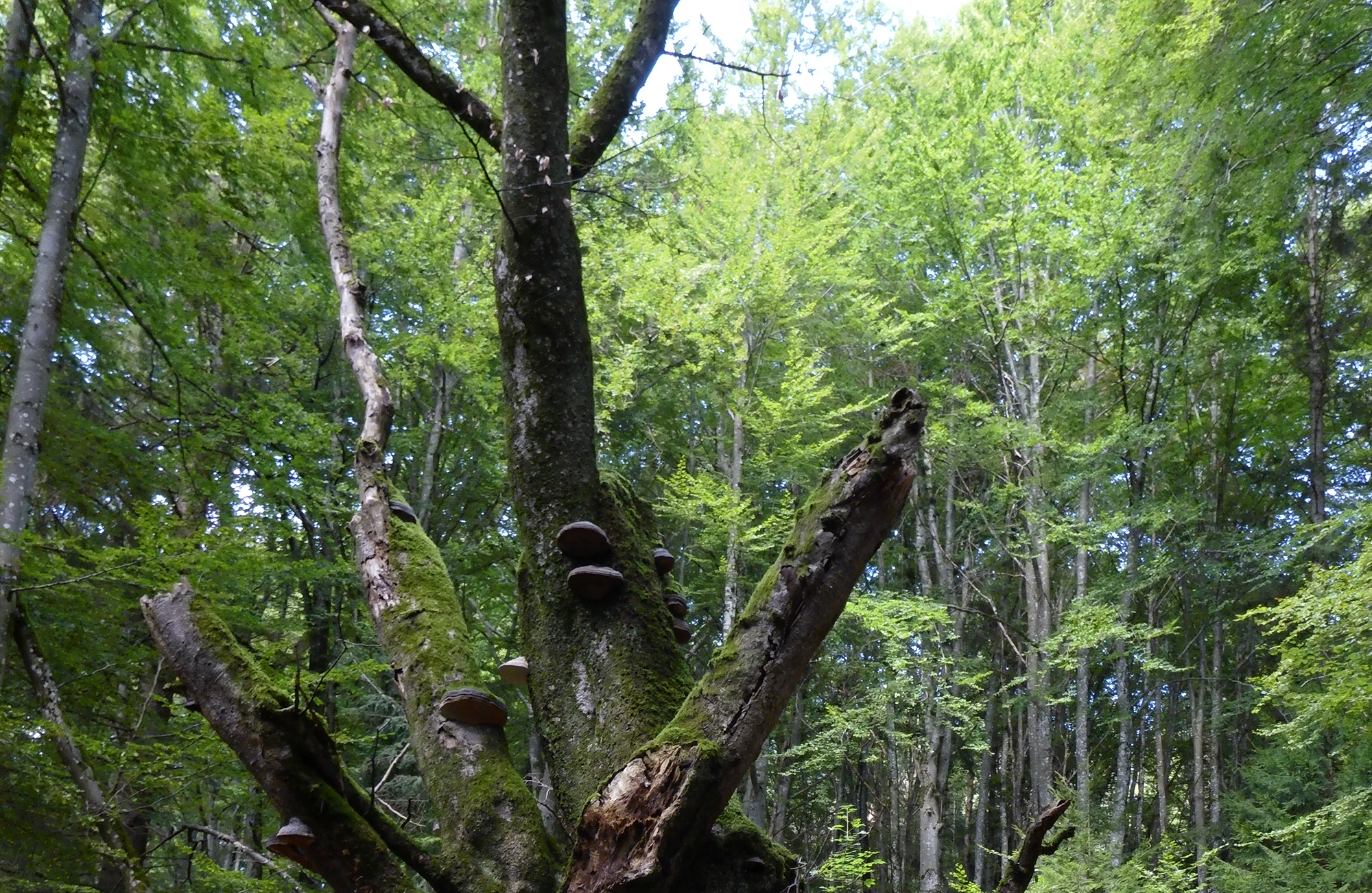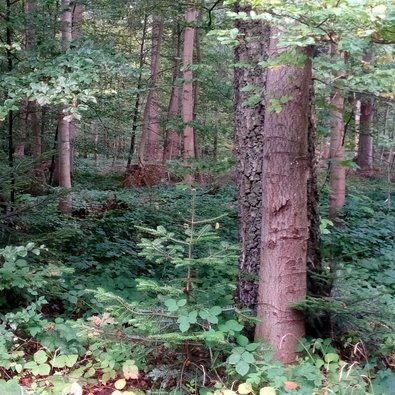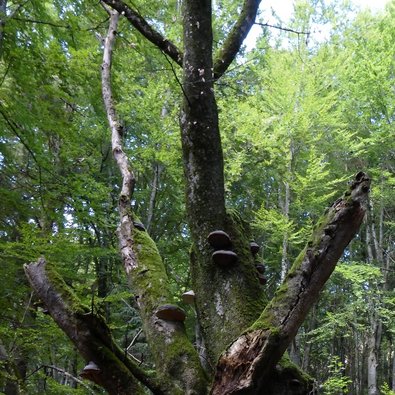
Fig. 1. Unused woodland with deadwood. Photo: Doris Hölling (WSL)
Wood consists of around 50% carbon. As long as the carbon is stored in the forest, it does not enter the air as CO2. Around 30% of Switzerland is covered by forest. The timber stock by area is among the highest in Europe. But as we all know, trees do not keep growing forever. This means that sooner or later, there is a natural end to the storage of carbon in a forest. So you can only fill the forest “container” once. Once a forest has reached a state of equilibrium, the net carbon sequestration is zero. A primeval forest like this stores a certain amount of carbon, but sustainable use (i.e. use over a long period) through timber harvesting is out of the question.
Within these key preconditions, it is legitimate to ask whether measures that promote biodiversity can also promote carbon storage.
Wood stock versus use
Some key findings from biodiversity research can help here:
- According to the principle of redundancy, a greater number of species offers insurance against total failure, because it is unlikely that a damaging event will affect all of them to the same extent.
- A disturbance increases biodiversity because it makes it possible for species to coexist, i.e. it prevents individual species taking over.
- Species communities go through natural cycles (succession), so there is no single final state. Forest degradation and regeneration can occur side by side.
- Habitat diversity increases biodiversity.
- Within certain limits, the diversity of tree species can enhance forest productivity, because different species use the resource supply differently and this can be complementary. However, the evidence supporting point 5 is meagre and it has only been demonstrated for the unnatural condition of cohort forests, with trees of the same age.
Unfortunately, there is still a widespread view that productivity has something to do with the volume of stock, although this is like confusing turnover and capital in business. The timber volume is the result of the time it takes to grow, i.e. the lifespan of trees. As a rule, however, fast-growing trees die earlier than slow-growing trees (poplar vs. oak). So the relationship is a negative one. In the natural forest left to itself, the relationship between natural mortality and regeneration determines the volume of stock. The more old trees there are in a closed forest, the bigger the stock. We talk about the tree demography that determines the stock volume. In the commercially managed forest, on the other hand, it is the forester who determines the stock - by determining the harvesting time (rotation period).
There are now two ways to store carbon in plant mass beyond the life of a tree: as deadwood in the forest, or built into houses and furniture. Surprisingly, the two are similarly effective. In our climate, it takes an average of 72 years for a fallen beech or spruce tree to decay by 90%, and about 62 years for timber that has been used for construction. If all types of wood use are included (i.e. including our daily newspapers), the average retention time of the carbon bound in it is 20 years according to this study - as short as that of coarse branch wood.
Consequences of non-use of forests
If a commercially used forest or a forest that has hardly been used so far is left to its own devices, as is the case in a natural forest reserve, the starting condition of the forest has a strong influence on what happens. If it is a cohort forest, i.e. a forest consisting of trees of a similar age, the forest will continue to accumulate biomass for a while. At the same time, however, the probability of self-thinning increases (individual trees die and create gaps), or a random event (e.g. windthrow) may create space over an extensive area. In both cases, the result is a gain in biodiversity - but a loss of carbon stocks. Forests that have barely been used are naturally patchy; habitat diversity and thus biodiversity are established earlier here.
If a commercially used forest or a forest that has hardly been used so far is left to its own devices, as is the case in a natural forest reserve, the starting condition of the forest has a strong influence on what happens. If it is a cohort forest, i.e. a forest consisting of trees of a similar age, the forest will continue to accumulate biomass for a while. At the same time, however, the probability of self-thinning increases (individual trees die and create gaps), or a random event (e.g. windthrow) may create space over an extensive area. In both cases, the result is a gain in biodiversity - but a loss of carbon stocks. Forests that have barely been used are naturally patchy; habitat diversity and thus biodiversity are established earlier here.
It is fairly unlikely that the quantity of deadwood in a forest left to its own devices can compensate for the loss of carbon stock caused by gaps. Mature natural forests are often quite open forests. Large wild animals can help keep such clearings open. When a forest is not used, it initially becomes more dense. However, it is misleading to consider this to be a permanent carbon sink. Old and tendentially open forests are also more susceptible to windthrow and less able to withstand avalanches.
Both natural forest reserves [no intervention], and special forest reserves [intervention to promote particular processes], are highly valuable for biodiversity. Numerous species are dependent on old and deadwood, or on sparse, light forests. However, unused forests are unlikely to have any additional value in terms of carbon storage. At the same time, the temporally limitless, sustainable substitution of fossil fuels through the use of wood is lost completely.
It is thus a question of weighing up the value of the various services provided by the forest. We have enough forest to be able to afford natural forest reserves, without having to justify this measure with an inappropriate carbon argument.
Translation: Tessa Feller


